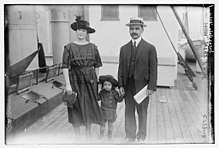Aarón Sáenz Garza
Aarón Sáenz Garza (1 June 1891 – 26 February 1983) was a Mexican politician.[1]

Biography
He was born in Monterrey, Nuevo León.
Sáenz Garza served as Secretary of Foreign Affairs during Calles' time as president. During his tenure, he continuously defended the Calles Administration's decision to cut oil to the United States when US Secretary of State Frank Kellog tried to bargain for a deal.[2][3] He soon became Governor of Nuevo León and maintained close ties with Calles; as governor, he even sat with Calles when he questioned the assassin of President-elect Alvaro Obregon in 1928.[4] It was also announced that Calles had plans to nominate him as the Chairman of the National Revolutionary Party.[5] President Pascual Ortiz Rubio appointed him Secretary of Public Education on February 1930. By 1934, Saenz had been dubbed as the "Shadow of Calles" and was named Governor of Mexico's Federal District by Mexican President Lázaro Cárdenas.[6] Cardenas and the Mexican Congress, however, soon turned on both Calles and Saenz and condemned their continued persecution against Catholics in the country.[7]
After leaving office in 1935, Saenz established a sugar corporation and quickly revolutionized sugar production in the country.[8] He was also known as the "king of Mexican sugar", founding a dynasty which survives until this date, led by his son Aaron Saenz Couret and grandson Aaron Saenz Hirschfeld, at the head of the leading sugar company in Mexico. At one point, he held a virtual monopoly of Mexico's sugar industry.[9] His monopoly, however, was brought down during the administration of Mexican president Adolfo Ruiz Cortines by 1953.[9] Saenz was married to Margarita Couret, with whom he had eight sons.
He died on 26 February 1983.
Businesses
For some time they all managed varied branches of the family's businesses, most of which have ceased to exist or passed into others' ownership. Most notable among these were:
- Mexicana de Aviación (Now bankrupt)
- Sugar mills
- Seguros Atlas—merged with Seguros Comercial America in the 90's and afterwards sold to France's AXA
- Banca Confía—nationalized in 1982, only to be re privatized by Carlos Salinas de Gortari's administration and passing into the hands of Jorge Lankenau's insurance group, later to be merged with Banamex and acquired by Citibank during President Ernesto Zedillo's administration.
Legacy
Aarón Sáenz was related to Raul Saenz, a prominent Mexican businessman in Chihuahua state, as well as Moises Saenz, a prominent Mexican educator and diplomat.
References
- Profile of Aarón Sáenz Garza
- "MEXICO: Vexful Waiting". Time. 1926-12-06. Retrieved 2013-03-12.
- "Foreign News: Secrets". Time. 1927-03-14. Retrieved 2013-03-12.
- "MEXICO: Must keep calm!". Time. 1928-07-30. Retrieved 2013-03-12.
- "MEXICO: New President". Time. 1928-12-10. Retrieved 2013-03-12.
- "MEXICO: Palm Down". Time. 1934-12-10. Retrieved 2013-03-12.
- "MEXICO: Ossy, Ossy, Boneheads". Time. 1935-02-04. Retrieved 2013-03-12.
- Aarón Sáenz; Mexico's revolutionary capitalist, James C. Hefley, pg. 93
- "MEXICO: The Domino Player". Time. 1953-09-14. Retrieved 2013-03-12.